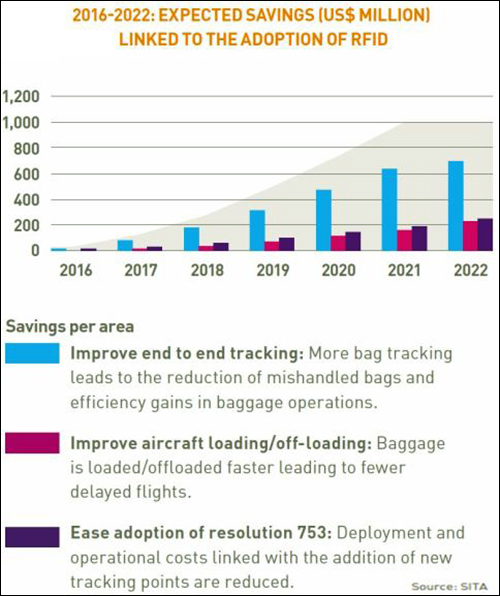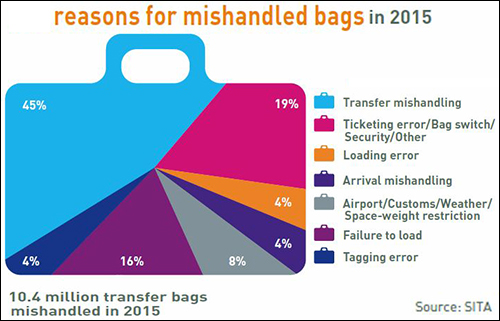A recent study conducted by the International Air Transport Association (IATA) and SITA predicts that the airline industry is poised to save a total of approximately $3 billion by the end of 2022 by employing ultrahigh-frequency (UHF) radio frequency identification technology to increase baggage-handling efficiency and reduce the incidence of errors. During that same span of time, RFID is expected to reduce the number of mishandled bags by 25 percent. In order for this to happen, the report notes, most of the world’s airports would need to deploy the technology. However, IATA and SITA believe, such wide-scale adoption will likely happen as a result of Resolution 753, an IATA directive from the airline industry requiring every piece of luggage to be tracked across the key points in a bag’s journey from origin to destination.
The savings is calculated based on the assumption that most airlines will have deployed RFID-based baggage-tracking infrastructure by 2021.

SITA, an IT company focused on the air-transport sector (including airlines and airports), teamed up with IATA this year to create a business case that it released last month. The report, titled “RFID For Baggage Tracking,” calculates the potential benefits to airlines and airports of utilizing bag tags made with passive EPC Gen 2 UHF RFID inlays. The organizations found that the $3 billion savings would be achieved based on the more efficient capturing of baggage data (as opposed to requiring bar-code scans), improved luggage visibility and a gain in operational efficiency that would reduce the occurrence of misplaced bags.
Airline travel is continually rising, with about five percent more passenger trips being taken every year since 2006, reaching 3.55 billion passenger flights worldwide in 2015. Currently, passengers check approximately 3 billion bags annually as they fly with airlines throughout the world.
To improve baggage-handling efficiency and accuracy, IATA issued Resolution 753, to be implemented by June 2018. This resolution requires that airlines identify every bag as it passes through points of transfer or routing, undergoes security screening and is loaded onto an airplane, as well as unloaded and received by the customer.
To improve baggage handling in anticipation of Resolution 753, several airlines have launched UHF RFID baggage-tracking deployments or pilot. This includes Delta Air Lines, which has undertaken one of the largest baggage-tracking rollouts of RFID technology (see Delta Gives Green Light to RFID Baggage Tracking). The airline will invest $50 million to deploy the technology at 344 airports, according to Peter Drummond, SITA’s head of baggage, and that initiative is piquing the interest of other airlines as well. “We may be at a tipping point in the [RFID] adoption,” he says.
Delta did not respond to RFID Journal’s requests for comment. On its website, however, the company says it began globally deploying RFID-embedded baggage tags this year, and indicated last month that it “has RFID hands-free scanning technology up and running at 25 stations with more stations coming online in the coming months, totaling 84. These airports account for more than 85 percent of the bags flying Delta.”
In addition, Delta recently announced a new map enhancement for its Fly Delta mobile app. The app, the airline reports, takes advantage of the location information provided by Delta’s RFID deployment. When a customer wants to view the location of his or her bag on the map, the display starts by showing a zoomed-out map of the United States as the luggage travels from one airport to the next. The map automatically zooms to airport view, and the user can then follow his or her baggage along its journey via pins, with the last known location identified by a suitcase icon. Tapping any pin or icon provides additional text information regarding the bag’s location.
Australian airline Qantas has been employing RFID-enabled baggage tags for domestic flights since 2010 (see Qantas Launches Its Next Generation Check-in System). Several other U.S. airlines besides Delta have indicated plans to deploy RFID within the next two years.

“SITA, through its baggage-tracking initiative, will also continue to conduct several trials and proof-of-concepts with airlines and airports around the globe in 2017,” Drummond says.
According to the study, mishandling has been costing the airline industry around $2.3 billion annually. At the same time, the report adds, passengers have a high expectation that baggage information will be available to them during their trip.
Mishandled bags, as defined in the report, include those delayed, damaged, lost or stolen. According to the study, the highest rate of mishandling takes place during moments when a bag is being transferred from one aircraft or airline to another.
On one hand, Drummond says, the baggage-mishandling rate has been on the decline, dropping 25 percent during the past few years. “There are a number of activities that have brought about the reduction in the mishandled baggage rate over the past decade,” he states, citing luggage-reconciliation systems, the addition of tracking points that read bar codes and IT operational process changes.
“Today, less than 1 percent of all bags are mishandled. However, any mishandled bag is a bag too many,” Drummond says. “Passengers quite rightly demand that their bags arrive with them every time, while the cost of mishandled bags remains a drain on the industry.”
RFID technology can help to drastically reduce the mishandling rate that remains, the study explains. For airlines, the report describes an approach consisting of an identity layer, first and foremost, that uniquely identifies every checked bag by means of an ID number linked to that item and its destination. This could be accomplished either via a reusable RFID tag with an ID linked to a new destination for each flight on which it is used, or with a single-use tag that could contain details—such as the bag’s destination—encoded on the tag’s RFID chip.
The passenger layer would serve as the airline’s interaction with passengers, both to provide them with the tags and to inform them about the journey of their baggage. Single-use tags could be provided to travelers as they check their luggage, while reusable tags could be available to purchase. In the case of reusable tags, passengers could also download an app that could provide information related to each tag read throughout the journey. For instance, they could opt to be alerted if their luggage were loaded onto or unloaded from an aircraft.
A handling layer would provide airline personnel with alerts in the event that a handling mistake were being made. For instance, if a bag were moving down a conveyor toward the wrong flight, the tag read could enable software to detect that action and initiate corrective measures, such as sounding an alarm or stopping the belt until the bag could be moved.
Lastly, a tracking layer provides airlines with a journey-wide view of a bag. This includes capturing when that luggage is checked in, loaded onto an aircraft, transferred to another plane and unloaded upon arrival at its destination.
The study recommends the use of either fixed or handheld RFID readers at airports to track the multiple steps that a bag undergoes while being transported. Fixed readers could be installed at baggage drops, above the conveyors and alongside belts used to load or unload an aircraft. Employees could utilize a handheld when a bag needs to be manually processed—for instance, if a passenger needs to change planes and his or her bag must be located and removed.
While airlines are responsible for deploying the baggage-tracking system to meet the Resolution 753 deadline in 2018, Drummond says, airports would typically fund the infrastructure installation. “Some airlines, such as Delta, have paid for the new infrastructure needed to deploy RFID,” he notes. So far, Delta’s RFID-based baggage-tracking deployment has been limited to the United States.
The IATA-SITA study forewarns airports and airlines to hire specialists to deploy and integrate the RFID readers, so that they can properly handle the data collected from the tags.
“The key to ensuring the effective rollout of RFID is to build a critical mass of airports and airlines that use RFID, allowing airlines to use the same technology no matter where they fly,” Drummond states. “Delta is the first major airline to do so, and we expect others to follow in the coming months.”


